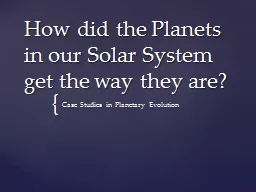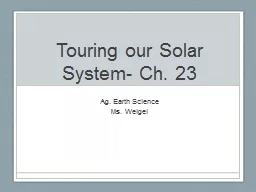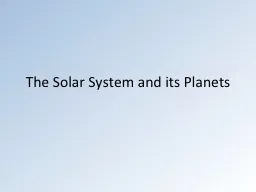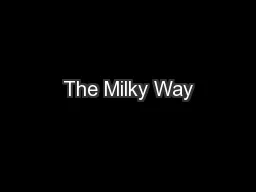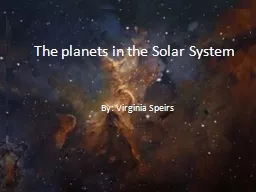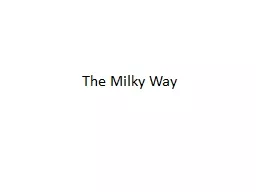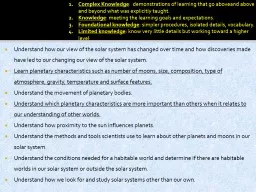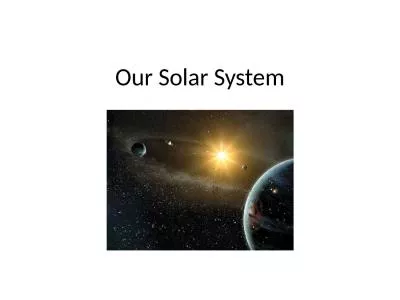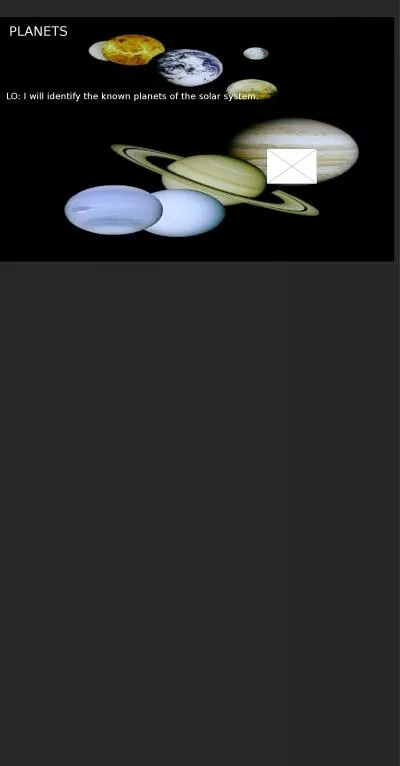PPT-How did the Planets in our Solar System get the way they are?
Author : tawny-fly | Published Date : 2018-12-07
Case Studies in Planetary Evolution Beginning presolar nebula T Tauri star Accretion of planets in protoplanetary disk Sun enters main sequence accretion ends
Presentation Embed Code
Download Presentation
Download Presentation The PPT/PDF document "How did the Planets in our Solar System ..." is the property of its rightful owner. Permission is granted to download and print the materials on this website for personal, non-commercial use only, and to display it on your personal computer provided you do not modify the materials and that you retain all copyright notices contained in the materials. By downloading content from our website, you accept the terms of this agreement.
How did the Planets in our Solar System get the way they are?: Transcript
Case Studies in Planetary Evolution Beginning presolar nebula T Tauri star Accretion of planets in protoplanetary disk Sun enters main sequence accretion ends Planetesimals collide and shift orbits. By Joey Quattrini. Our solar system includes . 8. different planets.. The solar system is very, very big. You could say massive also.. The solar system has cold planets and warm planets.. The Sun. The sun is the star that keeps our planet warm and bright.. Ag. Earth Science . Ms. Weigel. 23.1 The Solar System . The Planets: An Overview. Two Groups of planets. Terrestrial Planets- Mercury, Venus, Earth and Mars- relatively small and rocky . Jovian Planets- Jupiter, Saturn, Uranus, and Neptune- are huge gas giants. Nebula . Theory. Summing Up. SNT Explaining the Solar System. The Solar System’s disk shape. Inherited from the motion of materials in the solar nebula. . The planets and moons mostly rotate and revolve in the same directions because they evolved from the same gas cloud. . The milky way. (seen from Bryce Canyon, UT). The Solar System. ?. “A . system. is a set of . interacting. or interdependent. components . forming an integrated whole” (Wikipedia). The Solar System. The processes by which stars and planets form are active areas of research in modern astrophysics. The formation of our own solar system is central to the first half of our course, and important to the second half as well when we study the formation of stars. The Greek philosopher Democritus (450–370 BC) proposed that the bright band on the night sky known as the Milky Way might consist of distant stars. Aristotle (384–322 BC), however, believed the Milky Way to be caused by "the ignition of the fiery exhalation of some stars which were large, numerous and close together" and that the "ignition takes place in the upper part of the atmosphere, in the region of the world which is continuous with the heavenly motions.“ The . By: Virginia. . Speirs. The Solar System. The solar system is made up of many different things. There are 8 planets in our solar system. . The Inner Planets. The inner planets are the four planets closest to the sun. The inner planets are - Mercury, Venus, Earth, . 4.1 . The Search for Origins. Goals:. Where did the solar system come from?. How did it form?. When did it form?. What properties of our solar system must a formation theory explain? . Patterns of motion of the large bodies . Neoplatonist. philosopher . Olympiodorus. the Younger (c. 495–570 AD) criticized this view, arguing that if the Milky Way were sublunary it should appear different at different times and places on the Earth, and that it should have parallax, which it does not. In his view, the Milky Way was celestial. This idea would be influential later in the Islamic world.. Learn planetary characteristics such as number of moons, size, composition, type of atmosphere, gravity, temperature and surface features.. Understand the movement of planetary bodies.. Understand which planetary characteristics are more important than others when it relates to our understanding of other worlds. . Our solar system is ancient. . Early . astronomers believed that Earth was the center of the universe and all other heavenly bodies orbited around Earth.. Our Solar System. We now know that our sun is the center of our solar . Fill in the Comparing Planets Chart with what you already know about the planets.. How does Earth compare to other planets in the solar system?. S6E1c. Compare and contrast planets in terms of: size relative to earth; surface and atmospheric features; relative distance from the sun; ability to support life. SOLAR SYSTEM: all of the planets, moons, comets, and rocks that travel around the Sun. GALAXY: giant collection of gas, dust, and trillions of stars. Milky Way: our galaxy. Planet Sizes. PLANETS. Prepared by: Parshati Patel. Our Solar System. Our Solar System. Our Solar System. What makes up our Solar System?. Star (Sun). Planets (8). everything that orbits the Sun. Dwarf planets. Comets. Asteroids.
Download Document
Here is the link to download the presentation.
"How did the Planets in our Solar System get the way they are?"The content belongs to its owner. You may download and print it for personal use, without modification, and keep all copyright notices. By downloading, you agree to these terms.
Related Documents

